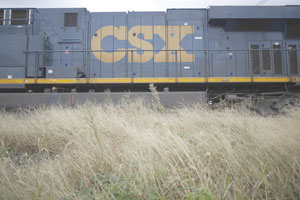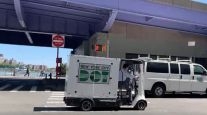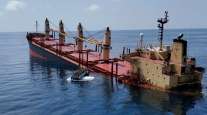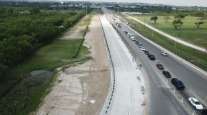Oversize Cargo Keeps U.S. Production on Track

Railroad and trucking operators are hauling more oversize cargo, helping to keep U.S. manufacturing activity on track for growth.
Carrying “large, bulky items” via rail — including oil-production and exploration equipment, turbines and airplane fuselages — has become a “very interesting” segment of the transportation industry, said Walter Kemmsies, chief economist for Moffatt & Nichol Inc., a Long Beach, California-based infrastructure-advisory company. That’s because the U.S. has a competitive advantage making these types of products, and production is rising, he said.
The United States exported $136 billion of goods in September on a seasonally adjusted basis, up 2.8% from a year ago, according to data from the Commerce Department. The rise was driven in part by capital goods and industrial supplies, which include items transported by rail or truck.
Demand for these products is helping companies such as Houston-based Specialized Rail Transport, which handles the logistics of moving oversize shipments on railways, said Kelli Collins, vice president of sales and marketing at the closely held business. There’s also been a trend toward larger items in recent years, she added.
“Manufacturers are trying to build things bigger and bigger, and I don’t see that changing anytime soon,” said Collins, president of the Railway Industrial Clearance Association in Spring, Texas. With “a lot more traffic on the rails,” Specialized Rail Transport probably will haul about 350 carloads of overdimensional cargo this year, up from 295 in 2013, she said.
U.S. manufacturing rose in October at a faster pace than projected, as the Institute for Supply Management’s factory index increased to 59, matching August as the highest since March 2011. Readings above 50 indicate expansion. An ISM gauge of production was the strongest in a decade.
Overdimensional shipments represent as much as $60 million of revenue for CSX Corp., the second-largest U.S. railroad operator by market capitalization, according to Dan Labyak, manager of the Jacksonville, Florida-based company’s clearance bureau. Power-generation equipment, including transformers, can be the most challenging, partly because manufacturers “break the mold” with each one, he said, adding that General Electric Co. is one of CSX’s big customers.
Because railroads own many of the tracks and bridges, standards for oversize shipments can vary by company. CSX requires special handling for cargo exceeding 11 feet in height and 10 feet, 8 inches in width, 60 feet in length and heavier than 150,000 pounds, Labyak said.
Another reason for the increase in oversize rail traffic is a change in state requirements for truck shipments, particularly after a 2007 bridge collapse in Minneapolis. Several state transportation departments have made it more difficult to get over-the-road permits, Labyak said.
If a manufacturer is trying to transport a transformer, CSX will work with that company’s logistics department, if it has one, to map out a route, coordinate the necessary clearances and provide an estimate for the cost and timing of delivery, Labyak said. With build cycles as long as 18 months, the final product could differ significantly from initial drawings, which creates additional challenges, he added.
The route could require temporarily installing another girder under a bridge or reconfiguring a load’s weight so it meets regulations, said Wesley Knapp, manager of nuclear and large projects in Greenville, South Carolina, for Edwards Moving & Rigging Inc.
Planning these itineraries is “like trying to maneuver a maze,” with variables such as construction and weather creating obstacles, he said.
A freight-forwarding company recently hired Edwards to assist Rolls-Royce Holdings PLC with hauling power-plant components built in Ohio to be shipped overseas, Knapp said. He and his colleagues were responsible for coordinating the road transportation.
The cost of such a project can vary, depending on the distance traveled, load size and modes of transportation. States also charge different fees, and there’s no “blanket permit” for the entire route, Knapp said.
The more times a shipment is handled, “the cost goes up and the risk goes up as well,” because of the need to deliver the shipment intact and ensure roads or bridges aren’t damaged along the way, Labyak said.
While some manufacturing sectors have slowed, orders for turbines, generators and other power-transmission equipment rose 11.5% in September from a year ago. As a result, business still is strong for the railway clearance association, a trade organization with more than 400 members, including CSX, Edwards Moving & Rigging and Specialized Rail Transport.
“The trend is definitely bigger and heavier,” Knapp said.




